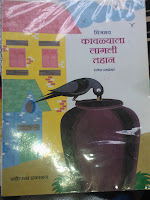We will soon be starting our "Tales with a Twist of Math (for 5-6 year olds)" story workshops across different locations in Mumbai (Colaba, Mulund, Juhu, Oshiwara & Kandivili).
Through this post, we are sharing an example of our story plan, to give you an idea, of how Math can be taught through stories and games.
 One of our stories in this series is about a little girl Samira and her shopping experience. We selected this story because, at this age, many children are keen to know the use of currency, and are capable of buying small items (under supervision) from shops.
One of our stories in this series is about a little girl Samira and her shopping experience. We selected this story because, at this age, many children are keen to know the use of currency, and are capable of buying small items (under supervision) from shops.
The story-hour begins with narrating the story. After the story is over, we tell children the importance of being eco-friendly and tell them the cons of using plastic bags for shopping. As a craft activity, we make them create their own eco-friendly paper shopping bags.
After the bags are created, it's time to shop! We display currency notes and coins of different denominations, and ask children to look at the samples and draw their own paper currency. The children need to write the numerals showing the currency amount, the country's name and draw a picture on each currency. To add to the fun, children can make their "family currency", that is, instead of drawing Gandhi's face on their currency notes, they can draw faces of their own family members on the different denominations. After they are done making their currency, they cut them out into individual pieces.
The final activity is "Shopping". They carry their paper bags and currency to the "pretend play" shop, which is setup in one corner of the class. The teacher/storyteller displays a shopping catalog on the counter. Each child approaches the counter and decides what items he/she wants to buy. They calculate and give the money to the teacher and buy their items.
Each one-hour session is designed to be "fun and play" for kids. Each of the stories in our pack extends into an activity or a game to teach basic math concepts. We use the NCERT curriculum as a guideline for choosing the concepts to be covered across each grade/age group.
 If you'd like to send your children to our workshops, then visit our website www.thestoryplace.in for more details.
If you'd like to send your children to our workshops, then visit our website www.thestoryplace.in for more details.
Alternatively, you could try the currency activity with your kids at home. We are sure they'll have a fun time making their own money, and you could setup a pretend-play vegetable shop or toy store at home and let them try their hands at shopping.
Through this post, we are sharing an example of our story plan, to give you an idea, of how Math can be taught through stories and games.
 One of our stories in this series is about a little girl Samira and her shopping experience. We selected this story because, at this age, many children are keen to know the use of currency, and are capable of buying small items (under supervision) from shops.
One of our stories in this series is about a little girl Samira and her shopping experience. We selected this story because, at this age, many children are keen to know the use of currency, and are capable of buying small items (under supervision) from shops.The story-hour begins with narrating the story. After the story is over, we tell children the importance of being eco-friendly and tell them the cons of using plastic bags for shopping. As a craft activity, we make them create their own eco-friendly paper shopping bags.
After the bags are created, it's time to shop! We display currency notes and coins of different denominations, and ask children to look at the samples and draw their own paper currency. The children need to write the numerals showing the currency amount, the country's name and draw a picture on each currency. To add to the fun, children can make their "family currency", that is, instead of drawing Gandhi's face on their currency notes, they can draw faces of their own family members on the different denominations. After they are done making their currency, they cut them out into individual pieces.
The final activity is "Shopping". They carry their paper bags and currency to the "pretend play" shop, which is setup in one corner of the class. The teacher/storyteller displays a shopping catalog on the counter. Each child approaches the counter and decides what items he/she wants to buy. They calculate and give the money to the teacher and buy their items.
Each one-hour session is designed to be "fun and play" for kids. Each of the stories in our pack extends into an activity or a game to teach basic math concepts. We use the NCERT curriculum as a guideline for choosing the concepts to be covered across each grade/age group.
 If you'd like to send your children to our workshops, then visit our website www.thestoryplace.in for more details.
If you'd like to send your children to our workshops, then visit our website www.thestoryplace.in for more details. Alternatively, you could try the currency activity with your kids at home. We are sure they'll have a fun time making their own money, and you could setup a pretend-play vegetable shop or toy store at home and let them try their hands at shopping.










